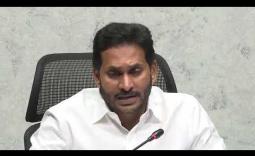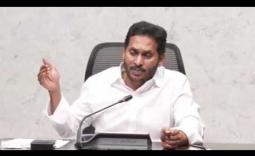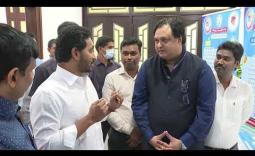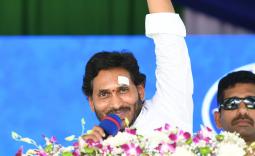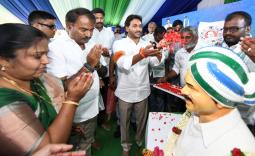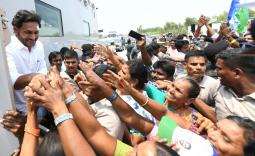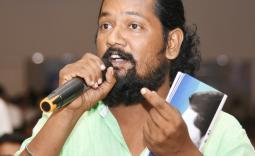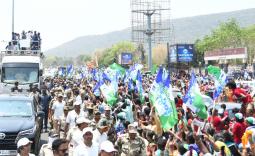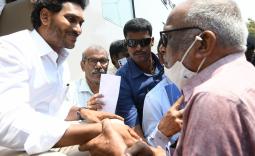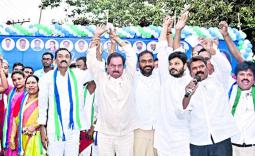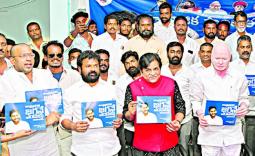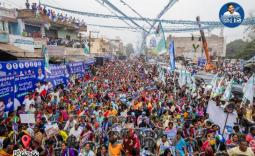YS Jagan Mohan Reddy expressed grief over the demise of Sri Shanti Swaroop A Peep Into CM Jagan’s Heart Of Gold!
A Peep Into CM Jagan’s Heart Of Gold! YS Jagan Mohan Reddy expressed delight over Bharat Ratna awards
YS Jagan Mohan Reddy expressed delight over Bharat Ratna awards AP Leads From the Forefront Disbursing Over Rs 4 Lakh Crore to the Poor via DBT
AP Leads From the Forefront Disbursing Over Rs 4 Lakh Crore to the Poor via DBT YSRCP's Impactful Welfare Measures
YSRCP's Impactful Welfare Measures YSRCP Highlights Plight of Dalits During Naidu's Rule
YSRCP Highlights Plight of Dalits During Naidu's Rule TDP, a BC Leader Factory, Yet No Representation in Rajya Sabha – Why?
TDP, a BC Leader Factory, Yet No Representation in Rajya Sabha – Why? Invested Rs 1,600 crore dedicatedly for the development of Kodur
Invested Rs 1,600 crore dedicatedly for the development of Kodur ‘Real development is providing quality education to poor and investing in human capital,’
‘Real development is providing quality education to poor and investing in human capital,’ Samajika Sadhikara bus yatra in Araku Valley, Anantapur
Samajika Sadhikara bus yatra in Araku Valley, Anantapur
YSRCP submits memorandum to CPM, DMK
08 Oct 2013 10:29 PM
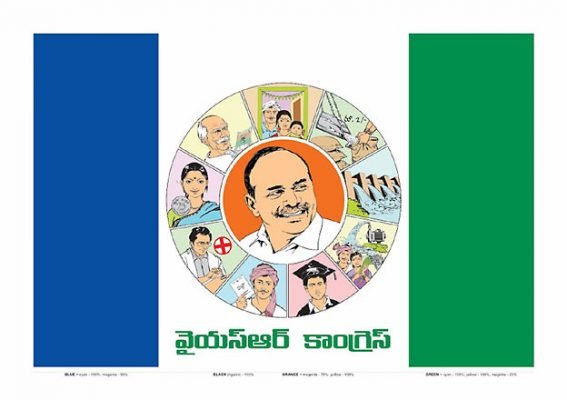
Dt: Oct 7, 2013
Sri Prakash Karat,
General Secretary
CPI (M)
Smt. Kanimozhi,
DMK Floor Leader, Rajya Sabha,
Respected Sir/Madam,
We are here to seek your support
in the issue of the proposed bifurcation of Andhra Pradesh as it was an
arbitrary decision of the Centre and against the wish of over 60 % of the State’s
population.
As you are aware, our
President, Shri Y.S.Jaganmohan Reddy, has undertaken an indefinite fast in the
State capital demanding the same.
We wish to place the
following facts on the gross injustice rendered to us for your kind perusal and
seek your support in this regard.
The Union Government has arbitrarily decided at a Cabinet Meeting on October
3 to divide the State to create Telangana state with
party garner a few MP seats in the Telangana region.
Consequently, the Union Government has appointed a GoM to somehow
apportion various resources among Telangana and Andhra states instead of
studying the feasibility of the very division itself.
In a liberal democracy like ours, where rule of law prevails, the State’s
action has to necessarily conform to rationale, objectivity, consistency and
transparency. As you are aware, no power vested in any public authority – be it
the Parliament or the Executive - is an absolute or unfettered power whih gives
scope for arbitrariness. Selectivity is a sworn enemy of Democracy. Article 3 of the Constitution of
new States on the reference from the President. However, such a power cannot be
exercised against the very spirit of democracy.
It may be recalled that the Justice Fazal Ali
Commission, popularly known as States Reorganization Commission, came up to
create linguistic States soon after Independence.
Several smaller States too were
carved out because of their linguistic identity like Tripura, Mizoram and
Nagaland.
Whereas the States Reorganization
Commission recommended creation of States on Linguistic basis, for creation of
the recent three states viz Jharkhand, Chhattisgarh and Uttarakhand, the
resolution of the state assemblies was taken as the basis for creation of
states, although this is not the requirement as per Constitution during the NDA
regime.
The Congress Working Committee, at
its meeting held on 30th October, 2000 considered the demands from
various regions of the country for separate statehood in detail and decided to
refer the matter to the Second States Reorganization Committee by passing the
following resolution.
"While respecting the report of the first States Reorganization
Commission, the Congress Party notes that there are many valid reasons for
formation of separate States in Vidarbha and Telangana. However, the Reorganization of existing States
raises a large number of issues. The
Congress Party feels that the whole matter could be best addressed by another
States Reorganization Commission to look into all the issues involved".
The AP Congress Manifesto 2004 reiterated the above stand.
Subsequently, the UPA Government constituted Shri Pranab Mukherjee Committee to
explore the possibility of achieving political consensus, which did not
accomplish its objective. In the meanwhile on 4th March 2009, the
Government of Andhra Pradesh appointed Sri Rosaiah Committee to address the
following 9 issues so that if satisfactory resolution to the said issues is
found the formation of Telangana could be taken up.
·
To identify the economic
issues that propel Telangana sentiment and to examine the facts relating to
employment, exploitation of resources, etc.
·
To examine the concerns
of minorities in the proposed Telangana set up.
·
To examine the status of
Area taking into consideration the migrant population.
·
To examine the concerns
of the migrant population in the rest of Telangana (excluding
·
To examine the issues
relating to Maoist and Terrorist activities in the context of proposed
Telangana set up.
·
To workout the modalities
for sharing of river waters vis-à-vis the existing situation.
·
Infrastructure and service
facilities at State capital – both State and Central Governments – relocation
and consequential issues.
·
To examine issues
pertaining to existing demands for separate States by other regions of the
State.
·
To work out a strategy
for the overall and harmonious development of all regions in the event of
formation of
Unfortunately, the State
Government did not undertake the study.
At an All Party meeting on
December 7, 2009 under the Chairmanship of Mr. Rosaiah, the then CM, the Congress
itself did not spell its preference while the MIM, the CPM and Lok Satta
opposed the division as against the BJP, the TDP, TRS and the CPI which support
it.
However, in a contrived
move, the Centre read it as a consensus in favour of Telangana and on December
9, 2009 announced the process of formation of
Following a backlash of
protests in Rayalaseema and coastal Andhra the Union Government appointed on February
3, 2010 a high powered committee under the stewardship of Justice Srikrishna on
the AP situation.
The Committee, which
studied the problem in depth for about 10 months, devoted 461 pages to compile
its report only to conclude that the best recourse was to keep the State
united.
The Justice Srikrishna Committee has opined that the State saw
significant economic and social progress over three decades to place it among
the front runners of progressive States in the country and added that the
demand for separate Statehood was more of a political nature.
Keeping the
report on the backburner, the Union Government began the process of political
consultations for a fourth time on December 28, 2013. Thereafter the Congress
party without formally announcing its stand on Telangana, placed the ball in
the CWC court on July 30, 2013.
It
may be recalled here that if sentiment that be then there is a sentiment in
Vidharba for separate statehood and the
creation of 3 new States. Struggles are being waged in Gorkhaland and Bodoland.
The Government ignored all these but got into the Telangana business only to
win a few Lok Sabha seats which can not be called a Constitutional ground for
the division of any State.
There
has been a spontaneous upsurge against this unilateral and arbitrary decision
in Seemaandhra region, with large number of people taking to streets against
the injustice meted out to them by this decision. The ongoing agitation which
is by and large apolitical and voluntary has paralyzed the entire
administration in the region with employees, teachers, professionals like
lawyers and doctors, farmers, students, women and children taking to the
streets.
The
main reason for this resentment is the timing of the decision and the
autocratic manner in which it was taken without finding solutions to a large
number of complex problems like the future of Hyderabad city, water andf
revenue sharing or the cost and time required to replicate a capital like
Hyderabad elsewhere.
Unlike other
state capitals, Hyderabad Metropolitan Development Area (HMDA) has emerged not
only as a political capital of Andhra Pradesh but also as an economic power house with all the
Public Sector and Private sector manufacturing units along with civil and
defence research laboratories being located in HMDA. Large number of industrial
investments have come up in and around
in the last 50 years only because it happened to be the capital of Andhra
Pradesh as a whole.
For instance when the
Central Government used the public sector as the main vehicle for the economic
growth of the country till mid-1990s, 90% of these investments had come up in
and around Hyderabad City, unlike in other States, where they were evenly
spread out among all the regions. For example, the BHEL that was sanctioned to
AP was located in Greater
UP locating it in a remote place like
or Tamilnad, in Trichy. Likewise, the Hindustan Antibiotic limited came up in
and in Maharashtra, in
Same is the case with HMT, BDL, IDPL, ECIL, BEL, Midhani, NFC, DMRL, HCL, DLRL,
DRDL, CCMB, IICT and DRDO. With the result, the entire ancillarization also taken
place in and around
More than 90% of the
private sector investment that came to
was from entrepreneurs from Andhra region known for their entrepreneurship and
business acumen. Some of these private enterprises have grown global. For
example, out of Rs. 55,000 crores of Software turnover (domestic plus exports)
from Andhra Pradesh for the year 2012-13, Hyderabad city itself accounted for
Rs, 54,800 crores. Andhra and Rayalaseema regions have essentially remained as
agrarian districts.
All the
institutions of higher learning and health care are also located in this area.
About 50% of the States own revenues are collected in HMDA area. This was not the case, for
instance, in the case of new States that were formed, viz., Jharkhand,
Uttarakhand and Chattisgarh.
If the division goes through, the Andhra state
after division will optimistically get only Rs 40,000 cr and the Telangana
state will get Rs 70,000 cr if the revenues of 2012-13 are apportioned on the
basis of district wise accruals, while Andhra area comprises 60% of the
geographical area and population of AP. There is no way these two will be able
to implement the welfare schemes and also meet the expenditure on salaries or
pensions.
More so, the residual AP part.
In these days of disinvestment, can we expect the government to invest
in major public sector undertakings in the residual AP region?
With the removal of licensing law, how can Central Government direct
the flow of private investments to any state?
How can Central Government ensure the 60% share of software business to
Andhra state, particularly when the Central Government, adding insult to
injury, recently decided to set up ITIR in HMDA area, where there already
exists huge software activity?
Without all these high profile economic activities and given the
complete bankruptcy of the Central Government how do we get money to run the
new state? Will Andhra remain only an agrarian state forever?
As for the Irrigation scenario a peculiar situation prevails in Andhra
Pradesh where several projects are conceived and executed on the basis of
surplus waters. Mahbubnagar, Nalgonda and Khammam districts of Telangana
region, Kadapa, Kurnool, Anantapuram and Chittoor districts of Rayalaseema
region, Praksam district of Andhra region are plagued by eternal drought and
fluoride problems. To solve the problems of people of these areas Government of
Andhra Pradesh started constructing huge projects on Krishna river like Bheema,
Nettempadu, Kalwakurthy and SLBC in Telangana region, Telugu Ganga, Galeru –
Nagari, Handri – Neeva in Rayalaseema region and Veligonda in Andhra region
based on surplus waters of Krishna . Nearly 70 to 80% of the works of these
projects were completed by spending around Rs.40,000 crores of public money.
The Bachawat Tribunal too allowed Andhra Pradesh to utilize flood waters
because AP is a lower riparian state and suffers immensely when monsoon fails.
If a new state is created in between, all these projects will turn into
monuments as they have no guaranteed allocation of water.
As far as the
division is restored back to
The Centre is unable to resolve the Kaveri disputes where the water is
assured and allocated on the one hand and how does it plan to resolve the above
issues with regard to Andhra Pradesh.
The Telangana protagonists
have been demanding a Telangana state that never existed as an exclusive
political entity at any point of time in the history. It is to be understood
that Andhra Pradesh was not the only State that was created on linguistic basis
in 1956 along with three others in
Again, it is not just the
Telangana region that was merged to create a separate State, several other
provinces too were either merged or demerged to create new linguistic states as
part of countrywide States Reorganization on linguistic basis. For instance,
from the erstwhile princely state of Hyderabad, the Telangana region comprising
10 districts were merged with Andhra state to form Andhra Pradesh, while the
Marathi speaking 6 districts of Maratwada were merged with Maharashtra and 3
Kannada speaking districts of Hyderabad state were merged with Karnataka state.
Thus, there is absolutely no truth in the argument that persons from
Andhra region have forcibly got Telangana merged in the then newly created
Andhra Pradesh. In fact, Andhra Pradesh as a State was created only after
passing resolutions in the assemblies of
people of Telangana. The Srikrishna committee has clearly established that the
Telangana region has indeed taken the lion’s share of the incremental growth
and development post formation of Andhra Pradesh in 1956. If sentiment of
Telangana for division has to be respected, the sentiment of other two regions
for keeping the state united has also to be respected.
The very
Central government is sitting on a financial powder keg and will not be in a
position to compensate the residual AP region after the creation of
As far as the Revenues of
the Central Government are concerned, the situation is very alarming. As per
Union Finance Ministry’s latest Monthly Economic Report, the Revenue receipts
for April-July 2013 were only Rs 1.76 lakh crores, recording a meager growth
rate of 4.3% against 23.1% for the corresponding period last year. What a fall!
This will definitely impact the flow of revenues from the Centre to States.
What is even more shocking is, in absolute terms, the revenue deficit at Rs
2.77 lakh crores for April-July 2013 is more than the total Revenue Receipts of
Rs 1.76 lakh crores for April-July 2013.
The only consideration that
the Union Cabinet has shown to Andhra region is to allow it to have its state
capital in
for a ten years period. Who will give the money to replicate
years? It is like forcibly vacating the owner of a house, which he had so
laboriously built for a period of 60 years, and give him permission to stay in
the house for ten years i.e. till he completes construction of new house, which
is any way impossible!! There is no money with Central Government to give to
Andhra state to construct the new capital. There will be no money with Andhra
state to meet its non-plan expenditure, let alone creating a capital and other
infrastructure, which it took 60 years in
to create.
God knows as to why the UPA
Government is so annoyed with Andhra region! Is it because they returned 22
Congress MPs out of the total strength of 25 MPs in 2009?
The division of Andhra
Pradesh after 57 years of its creation, particularly when people of Andhra and Rayalaseema
regions are tooth and nail opposed to such division, is therefore fraught with
serious political consequences not only within AP but also for the whole
country. AP is among the fastest developing states in the country having third
highest GDP in current terms, next only to UP and
All the three regions have registered good growth.
If sentiment is the reason
alone for bifurcation, then we will be ending up creating more States than we
united in 1947 to put in place our democratic
In a recent Presidential reference under Article 143 of the
Constitution of
regarding the alienation of natural resources, the Supreme Court clearly said
that as long as there is a policy in place, they will not interfere. On the
other hand, if the Government is following the policy of pick and choose, they
would definitely interfere. It therefore follows that even in respect of
creation of new states; the Central Government should come up with a policy and
conform to that. Otherwise, the Supreme Court has every right to intervene in
any decision that the Central Government may take in respect of creation of new
states.
In the light of these facts,
we earnestly request you to support the integrated State of
Yours faithfully




